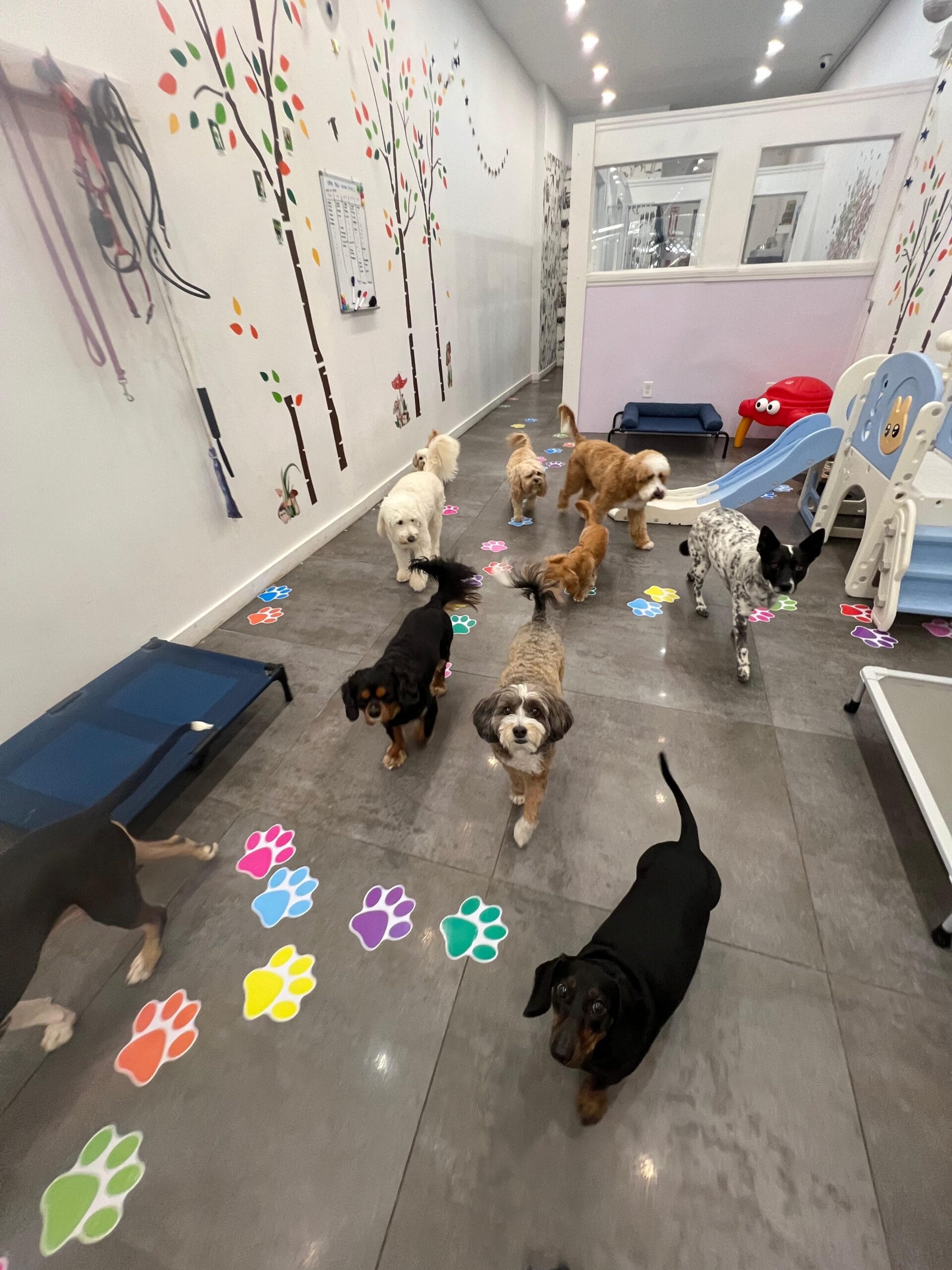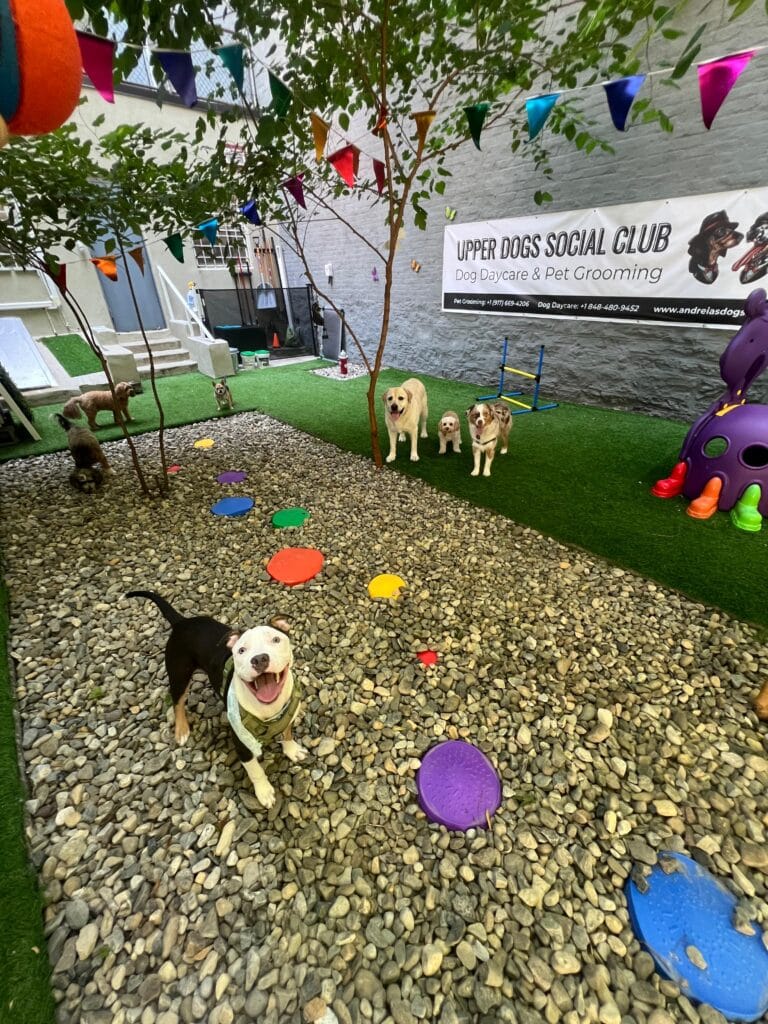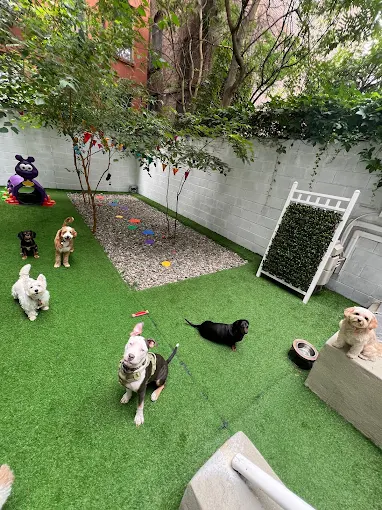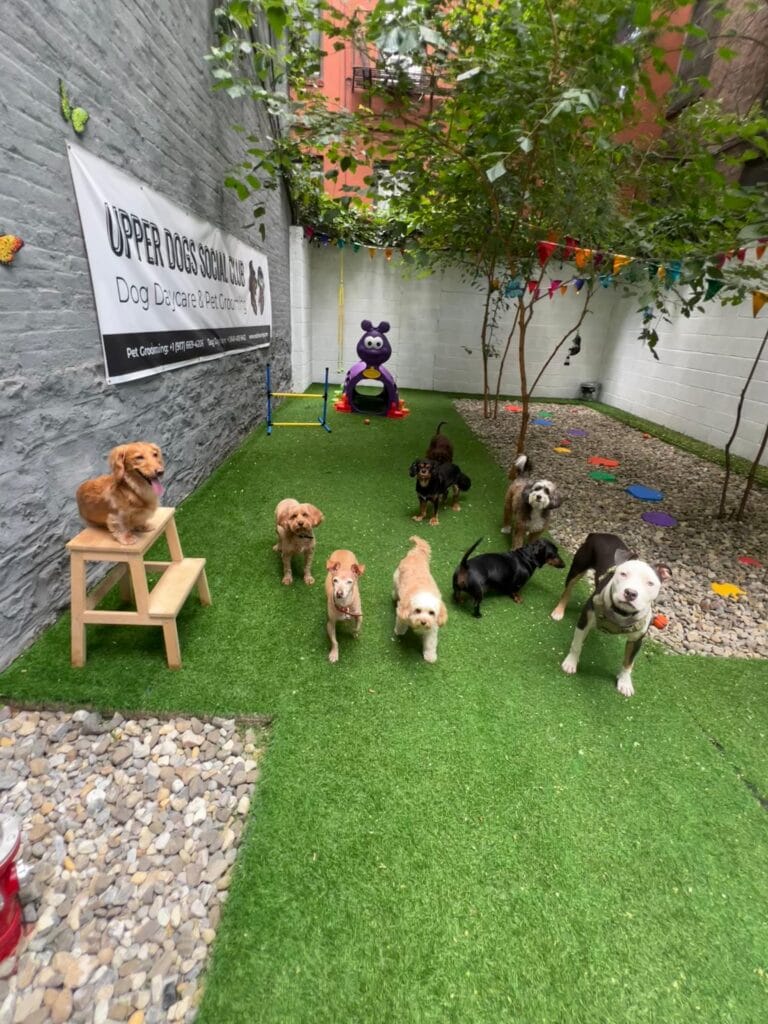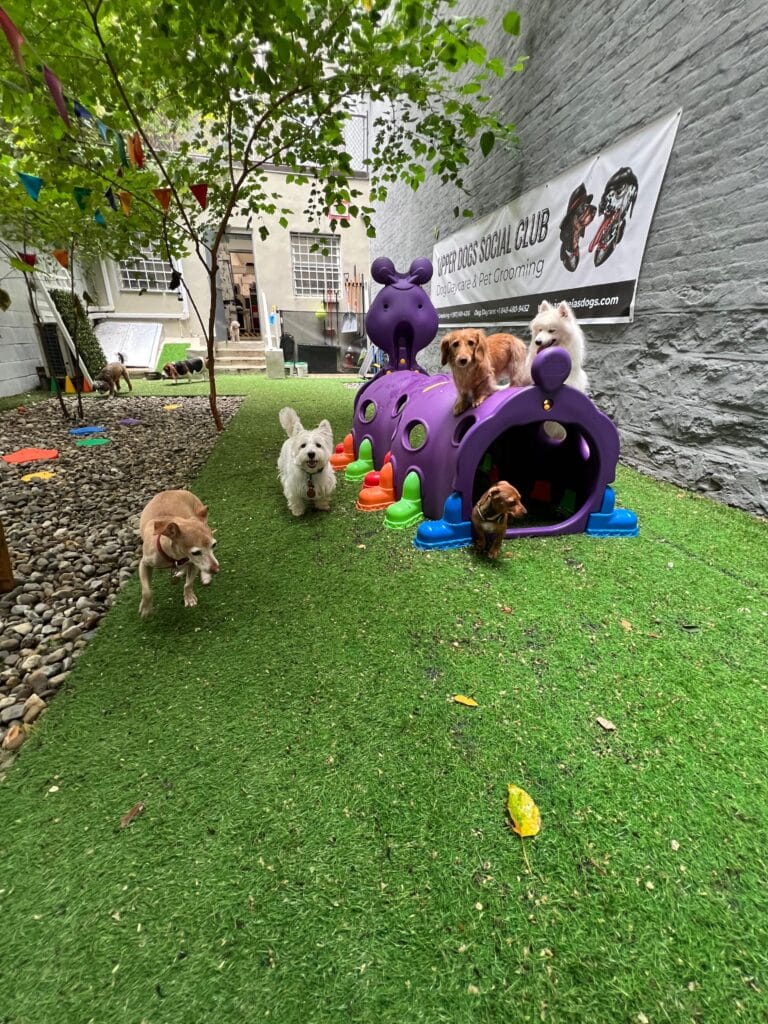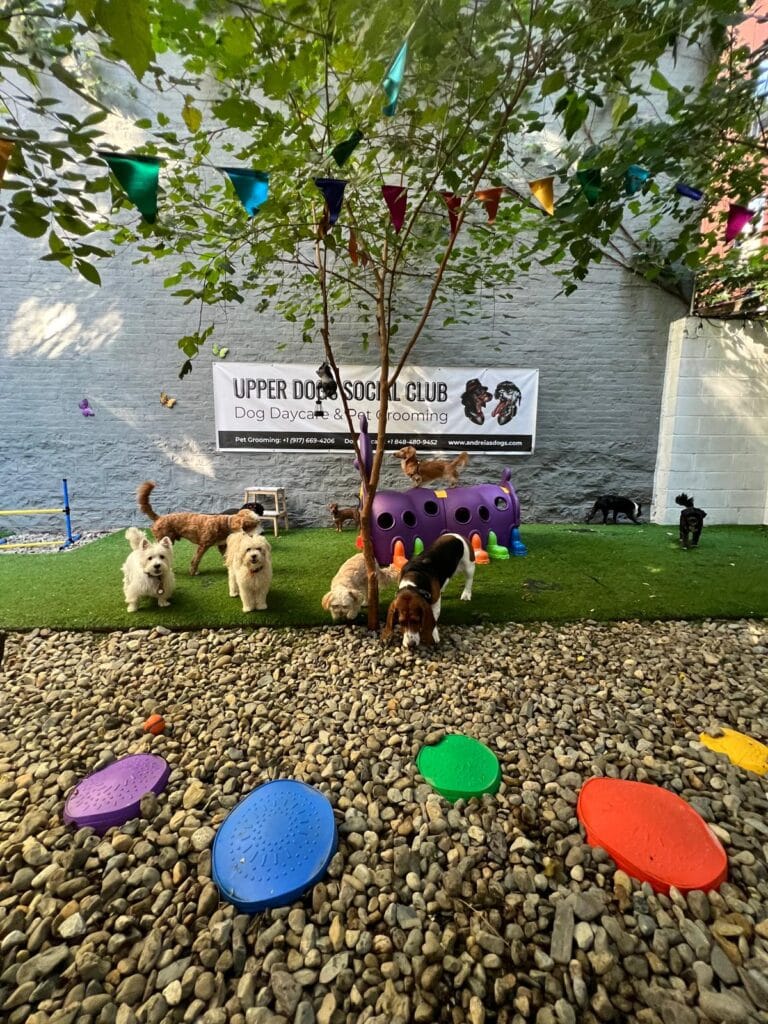Urban dog daycares face unique safety challenges that suburban facilities simply don’t encounter. Between busy traffic, air pollution, crowded sidewalks, and limited outdoor space, city-based dog daycare protocols must go above and beyond standard safety measures. For example, a dog daycare service in East Harlem NYC must implement extra precautions to ensure pets remain safe in such a high-density environment.
This guide is for dog daycare owners, managers, and staff working in urban environments who need practical strategies to keep their four-legged clients safe and healthy. We’ll also cover essential information for pet parents researching urban daycare options.
We’ll walk through the specific environmental hazards that make urban locations more dangerous for dogs, from traffic noise stress to toxic street substances. You’ll learn about the health screening protocols that city daycares need to protect dogs from urban-specific health risks. Finally, we’ll explore how secure facility design and specialized staff training can create a safe haven for dogs in the middle of a bustling city.
Urban Environmental Hazards That Threaten Dog Safety
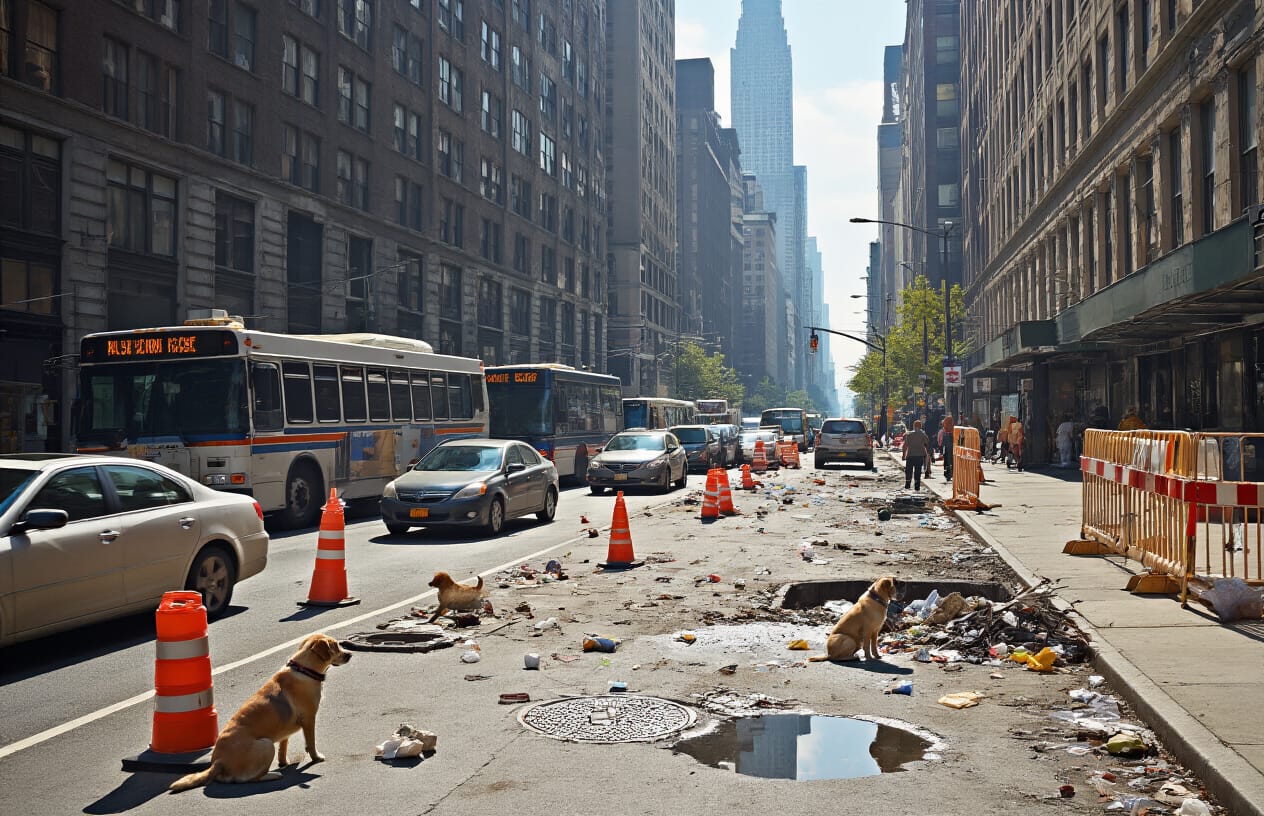
Traffic and Vehicle-Related Dangers
Urban dog daycare facilities face constant threats from heavy traffic patterns that simply don’t exist in quieter suburban settings. The sheer volume of cars, buses, delivery trucks, and emergency vehicles creates a maze of potential hazards that require careful navigation and strategic planning—something highlighted in Dog Daycare Solutions for Busy NYC Professionals: A Lifesaver. The proximity to busy intersections means dogs can be startled by sudden horn honking or screeching brakes, potentially causing them to bolt unexpectedly.
The proximity to busy intersections means dogs can be startled by sudden horn honking or screeching brakes, potentially causing them to bolt unexpectedly. Delivery trucks making frequent stops create blind spots and unpredictable movement patterns that pose risks during pickup and drop-off times.
Effective urban daycares implement multiple layers of protection:
- Secure vestibule systems that prevent dogs from accessing street-facing areas
- Designated safe zones for client transactions away from vehicle traffic
- Staff-escorted transfers between vehicles and facility entrances
- Visual barriers like fencing or landscaping to reduce street distractions
- Emergency protocols for handling traffic-related incidents
The constant flow of pedestrians, cyclists, and ride-share vehicles adds complexity to simple tasks like walking dogs or loading them into cars. Smart facility design accounts for these challenges by creating buffer zones and controlled access points that keep four-legged clients safely separated from the urban chaos outside.
Air Quality and Pollution Exposure Risks
City air carries a cocktail of pollutants that can seriously impact canine respiratory health. Vehicle emissions, industrial output, construction dust, and seasonal smog create conditions that are far from ideal for dogs spending extended periods outdoors. The ASPCA provides guidance on protecting pets from environmental hazards and improving their respiratory health
Brachycephalic breeds like bulldogs and pugs are particularly vulnerable to air quality issues, as their shortened airways already make breathing more difficult. Even healthy dogs can develop respiratory irritation or aggravated allergies when exposed to poor air conditions over time. For detailed advice on caring for sensitive breeds, see PetMD.
Modern urban daycares address air quality through:
- High-efficiency air filtration systems that continuously clean indoor air
- Air quality monitoring to track daily pollution levels
- Modified outdoor schedules that avoid peak traffic hours and high-pollution periods
- Indoor play alternatives during code orange or red air quality days
- Regular HVAC maintenance to ensure optimal air circulation
Some facilities invest in real-time air quality monitors that automatically adjust ventilation systems based on current conditions. This technology-driven approach allows staff to make informed decisions about outdoor activities while maintaining healthy indoor environments regardless of external air quality fluctuations.
Noise Stress and Overstimulation Factors
The urban soundscape creates a constant barrage of stimuli that can overwhelm even the most well-adjusted dogs. Construction equipment, emergency sirens, honking horns, and general city commotion combine to create stress levels that many dogs struggle to manage effectively.
Chronic noise exposure can lead to anxiety behaviors, difficulty settling during rest periods, and heightened reactivity to sudden sounds. Dogs may become hypervigilant or exhibit stress-related behaviors like excessive panting, pacing, or destructive tendencies.
Successful urban facilities combat noise stress through:
- Sound-dampening materials in walls, ceilings, and flooring
- Strategic facility layout that places quiet zones away from street-facing walls
- White noise systems or calming music to mask external sounds
- Structured quiet periods that allow dogs to decompress
- Staff training to recognize and address noise-related stress signals
Creating acoustic sanctuaries within busy urban environments requires intentional design choices. Double-pane windows, insulated walls, and soft furnishings help absorb sound while providing dogs with spaces where they can truly relax. The goal is transforming a potentially chaotic urban environment into a calm oasis where dogs can thrive despite the city’s constant activity.
Essential Health Screening Protocols for Urban Dog Daycares
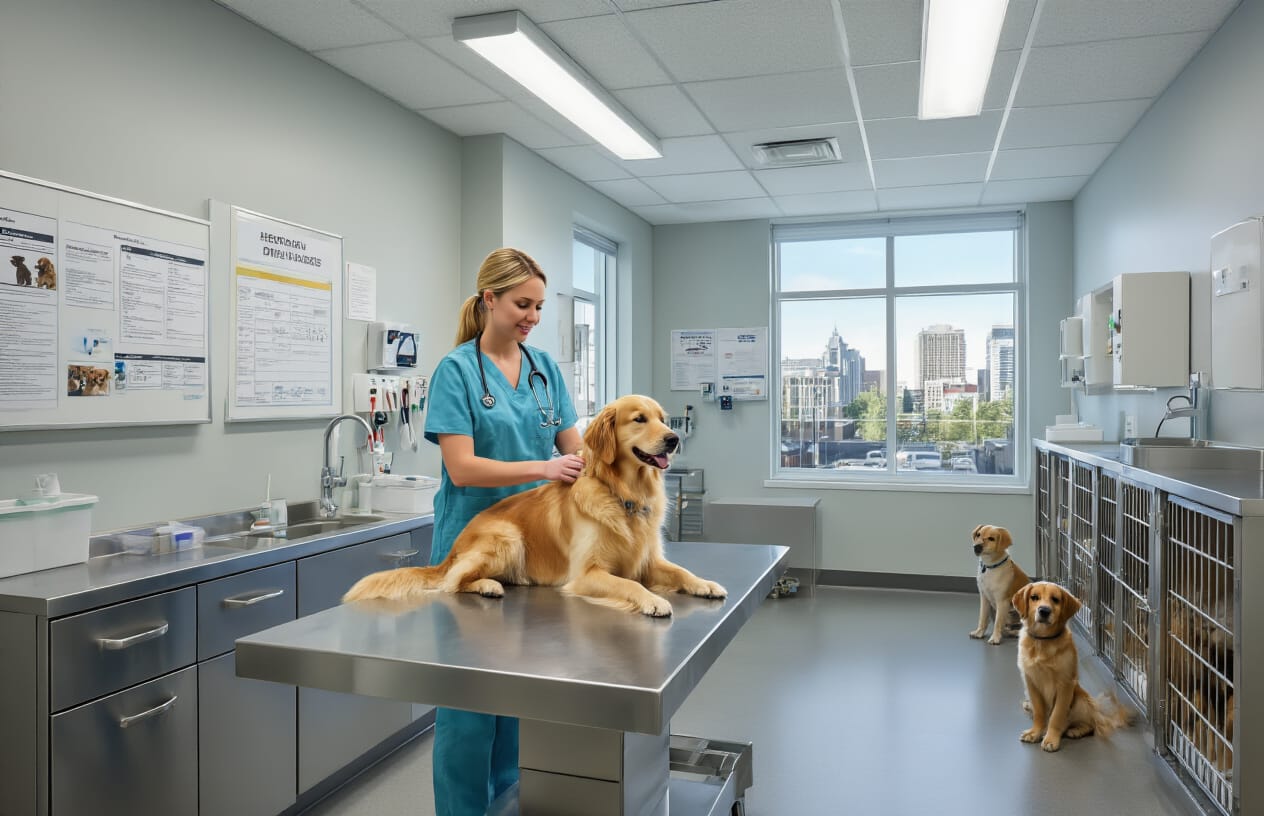
Pre-Admission Vaccination Requirements
Dog daycares in urban settings must maintain strict vaccination protocols to prevent disease outbreaks in high-density environments. Core vaccines including rabies, DHPP, and bordetella are non-negotiable requirements. The AVMA outlines recommended vaccination schedules and best practices for canine disease prevention.
Urban facilities should also require additional vaccines based on regional risk factors. Lyme disease vaccination becomes critical in areas with high tick populations, while leptospirosis protection is essential where dogs may encounter contaminated water sources or urban wildlife. Pet owners preparing for daycare enrollment can review these and other requirements in Preparing Your Dog for Their First Day at Manhattan Daycare, which outlines the key vaccines and health checks needed for a safe start.
All vaccination records must include specific vaccine brands, lot numbers, and expiration dates. Titers can serve as alternatives for core vaccines in dogs with documented adverse reactions, but these results must be from accredited laboratories and updated annually. Facilities should maintain a digital database tracking each dog’s vaccination status with automated renewal reminders sent to pet owners 30 days before expiration.
Regular Health Monitoring and Assessment Procedures
Daily health assessments form the backbone of urban daycare safety protocols. Staff members conduct visual inspections each morning, checking for signs of illness including lethargy, coughing, nasal discharge, vomiting, or diarrhea. Dogs showing any symptoms are immediately isolated and their owners contacted for pickup, while structured group activities also help improve socialization — learn more in Boosting Social Skills: How Dog Daycare Benefits Your NYC Pup.
Temperature monitoring proves especially valuable in detecting early illness stages. Normal canine body temperature ranges between 101-102.5°F, and any deviation warrants immediate attention. Weekly weight monitoring helps identify health changes that might indicate underlying conditions or stress responses to the urban daycare environment.
Behavioral assessment protocols document changes in appetite, energy levels, social interactions, and stress indicators. Urban dogs often experience different stressors than their suburban counterparts, including noise sensitivity, air quality reactions, and overstimulation from city environments. Staff maintain detailed logs tracking each dog’s normal behavior patterns to quickly identify concerning changes.
Monthly veterinary wellness checks conducted on-site provide professional health evaluations for enrolled dogs. These assessments include dental examinations, skin condition checks, and parasite screenings that complement owner-provided veterinary care.
Urban-Specific Disease Prevention Measures
Urban dog daycares face unique disease challenges requiring specialized prevention strategies. Air quality monitoring systems track pollution levels and adjust outdoor activities accordingly, as poor air quality can exacerbate respiratory conditions and increase susceptibility to upper respiratory infections.
Parasite prevention programs address urban-specific threats including increased flea and tick populations thriving in city environments. Monthly parasite preventatives are often required. The CDC provides guidance on zoonotic diseases and parasite control measures to protect pets and humans in urban settings.
Water quality testing ensures safe drinking sources, as urban water supplies may contain higher chemical concentrations or contaminants. Filtration systems and regular testing protocols protect against waterborne illnesses that spread rapidly in group settings.
Enhanced sanitation procedures combat the higher pathogen loads present in urban environments. This includes specialized disinfection protocols for surfaces exposed to outdoor contaminants, air filtration systems to reduce airborne pathogens, and strict hand hygiene protocols for staff transitioning between indoor and outdoor activities.
Disease outbreak response plans specific to urban settings address rapid veterinary access, emergency transportation routes avoiding traffic congestion, and communication protocols with local animal control and veterinary emergency services. These plans account for the unique challenges of managing health emergencies in densely populated areas where professional services may be overwhelmed during peak times.
Secure Facility Design Standards for City Locations
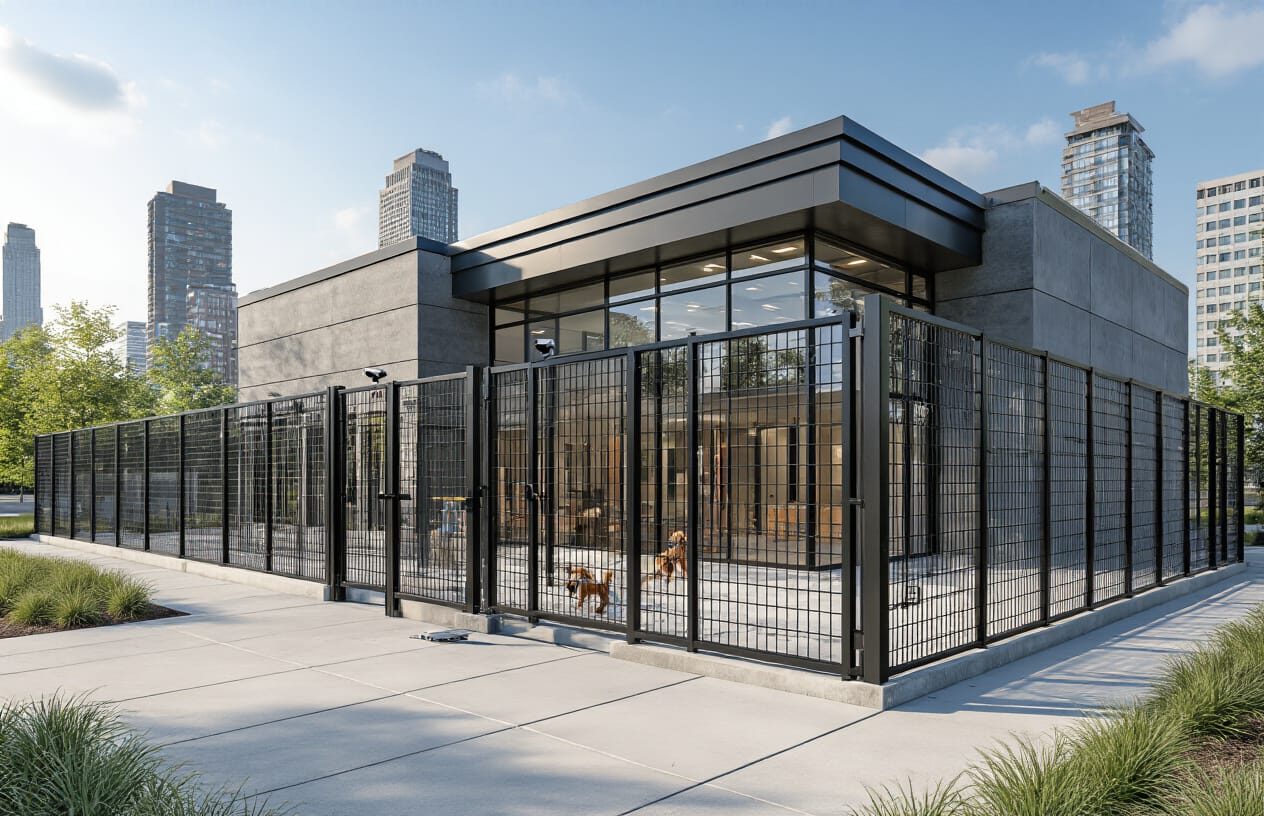
Multi-Level Security Systems and Access Control
Urban dog daycares face unique challenges that require sophisticated security measures to protect both animals and staff. A comprehensive access control system starts with biometric entry points that track every person entering the facility. Key card systems with time-stamped logs create an audit trail, while visitor management protocols ensure no unauthorized individuals gain access to play areas. For a deeper look at the standards that make city daycares exceptional, see What to Expect from a Premier Dog Daycare in Manhattan.
The most effective facilities employ a three-tier security approach: perimeter security with surveillance cameras, interior monitoring systems, and restricted access zones. Automated door locks prevent dogs from accessing dangerous areas like supply rooms or kitchen facilities. Smart sensors can detect when gates are left open or when animals move into unauthorized areas, triggering immediate alerts to staff members.
Digital monitoring systems should integrate with mobile apps, allowing managers to receive real-time notifications about security breaches. Motion-activated cameras in play areas serve dual purposes – they monitor for safety incidents while deterring potential intruders. Some facilities install panic buttons throughout the premises, giving staff instant access to emergency services when needed.
Staff identification systems prevent confusion during shift changes, while parent pickup verification processes ensure dogs leave only with authorized individuals. RFID tags on dog collars can trigger alerts if animals approach exit doors without proper authorization, adding an extra layer of protection against accidental escapes.
Safe Outdoor Play Areas with Protective Barriers
City-based dog daycares must create secure outdoor spaces that shield animals from urban hazards while maximizing play opportunities. As you evaluate facilities, guides like How to Choose the Best Dog Daycare in Manhattan: A Checklist can help you understand what proper outdoor safety standards should look like. Double-gate entry systems prevent escape attempts during busy pickup times, while eight-foot minimum fence heights deter jumping attempts from athletic breeds.
Ground surfaces require careful consideration in urban environments. Rubberized flooring or specialized artificial turf provides better traction than concrete while reducing injury risks from falls. Drainage systems prevent water accumulation that creates slippery conditions or attracts pests. Raised planters with dog-safe vegetation create natural barriers while improving air quality in polluted city environments.
Shade structures become essential in areas with limited natural coverage. Permanent awnings or retractable canopies protect dogs from harsh sun and sudden weather changes common in urban microclimates. Wind barriers help reduce noise pollution from traffic while creating calmer play environments.
Regular inspection schedules identify potential hazards like fence damage, loose hardware, or toxic debris blown in from city streets. Emergency water stations positioned throughout play areas help prevent overheating, while first aid stations stocked with appropriate supplies enable quick response to injuries. These safety measures are especially important for dogs who attend daycare frequently — understanding How Often Should Your Dog Attend Daycare in Manhattan NYC? can help you balance playtime with proper rest and recovery.
Emergency Exit Planning and Evacuation Routes
Urban dog daycares require detailed evacuation procedures that account for high population density and limited space constraints typical in city locations. Primary and secondary exit routes must remain clearly marked and unobstructed, with emergency lighting systems that activate during power outages. Staff training includes regular evacuation drills that simulate various emergency scenarios including fires, medical emergencies, and severe weather events.
Evacuation plans designate specific staff members to each dog group, preventing chaos during crisis situations. Emergency supply kits positioned near exits contain leashes, carriers for injured animals, and basic first aid materials. Communication protocols include emergency contact systems that automatically notify pet parents about evacuation procedures and alternate pickup locations.
Assembly areas should be predetermined locations away from the immediate building vicinity – often challenging in dense urban environments. Partnerships with nearby businesses or community centers provide safe gathering spaces during extended evacuations. Vehicle access routes for emergency responders require regular assessment to ensure fire trucks and ambulances can reach the facility without obstruction.
Documentation systems track which animals and staff members have been evacuated safely. Digital check-out systems accessible via tablets allow real-time accountability during emergencies. Weather-specific procedures address unique urban challenges like flooding in basement facilities or high-wind conditions affecting high-rise locations. Regular coordination with local emergency services ensures responders understand the facility layout and animal-specific rescue requirements.
Staff Training Programs for Urban Safety Management
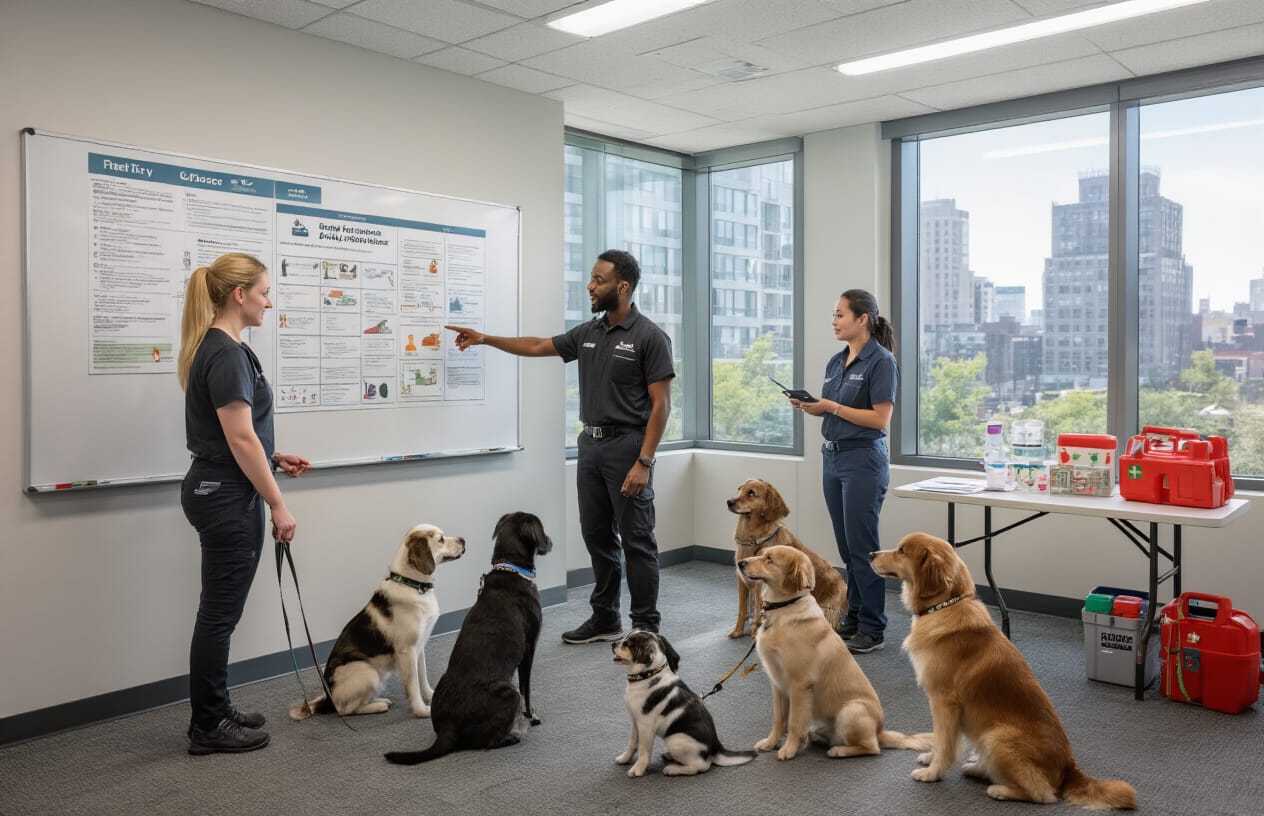
Emergency Response and First Aid Certification
Urban dog daycares face unique emergency situations that rural facilities rarely encounter. Staff members need comprehensive training that goes beyond basic pet first aid to address city-specific scenarios like vehicular accidents, chemical exposure from street treatments, and injuries from construction debris.
The certification program should include hands-on training with simulated emergencies. Staff practice treating dogs hit by vehicles, handling seizures triggered by urban noise pollution, and managing respiratory distress from air quality issues. Each team member learns to assess vital signs quickly, control bleeding, and stabilize injured animals before veterinary care arrives.
Documentation becomes critical during urban emergencies. Staff train to record detailed incident reports, photograph injuries for insurance purposes, and communicate effectively with multiple agencies that might respond to city emergencies. The training covers liability protection and proper communication with pet owners during crisis situations.
Regular recertification every six months keeps skills sharp and introduces new protocols as urban hazards evolve. Staff members rotate through different emergency scenarios monthly, building confidence and muscle memory that proves invaluable when real situations arise.
Urban Wildlife and Stray Animal Encounter Protocols
City environments host surprising wildlife populations that can threaten daycare dogs. Staff learn to identify and respond to encounters with urban coyotes, raccoons, and other wildlife. The Humane Society of the United States offers resources on safely managing interactions between pets and urban wildlife.
The protocol begins with environmental scanning during outdoor activities. Staff position themselves strategically to monitor blind spots where wildlife typically appears. They carry deterrent tools like noise makers and motion-activated lights to discourage unwanted animal approaches without harming the intruders.
Stray dog encounters require different strategies than wildlife management. Staff learn to assess stray behavior patterns, distinguishing between lost pets seeking help and aggressive dogs defending territory. The training covers safe capture techniques, temporary containment methods, and coordination with local animal control services.
Dogs in daycare show different reactions to wildlife encounters. Some become aggressive protectors while others freeze in fear. Staff training emphasizes reading group dynamics during these situations, separating reactive dogs quickly while maintaining calm energy that prevents panic spreading through the pack.
Crowd Control and Dog Behavior Management
Urban dog daycares manage larger groups in smaller spaces than their suburban counterparts. Staff training focuses on reading early warning signs of group tension before fights break out. They learn to spot resource guarding behaviors, recognize when dogs feel cornered by city noise, and identify stress signals that precede aggressive outbursts.
Effective crowd control relies on strategic positioning and group management techniques. Staff learn to create natural barriers using their bodies, redirect attention through engaging activities, and separate potential conflicts before they escalate. The training covers voice commands that cut through urban background noise and hand signals for silent communication between staff members.
Space management becomes an art form in city facilities. Staff practice rotating groups through different areas, managing door transitions safely, and creating calm zones where overwhelmed dogs can decompress. They learn to use vertical space effectively and establish clear pathways that prevent bottlenecks during high-activity periods.
Emergency evacuation procedures receive special attention in urban training programs. Staff practice moving large groups quickly through narrow city exits, coordinating with building security systems, and managing dogs during street-level evacuations where traffic and pedestrians create additional hazards.
Conclusion
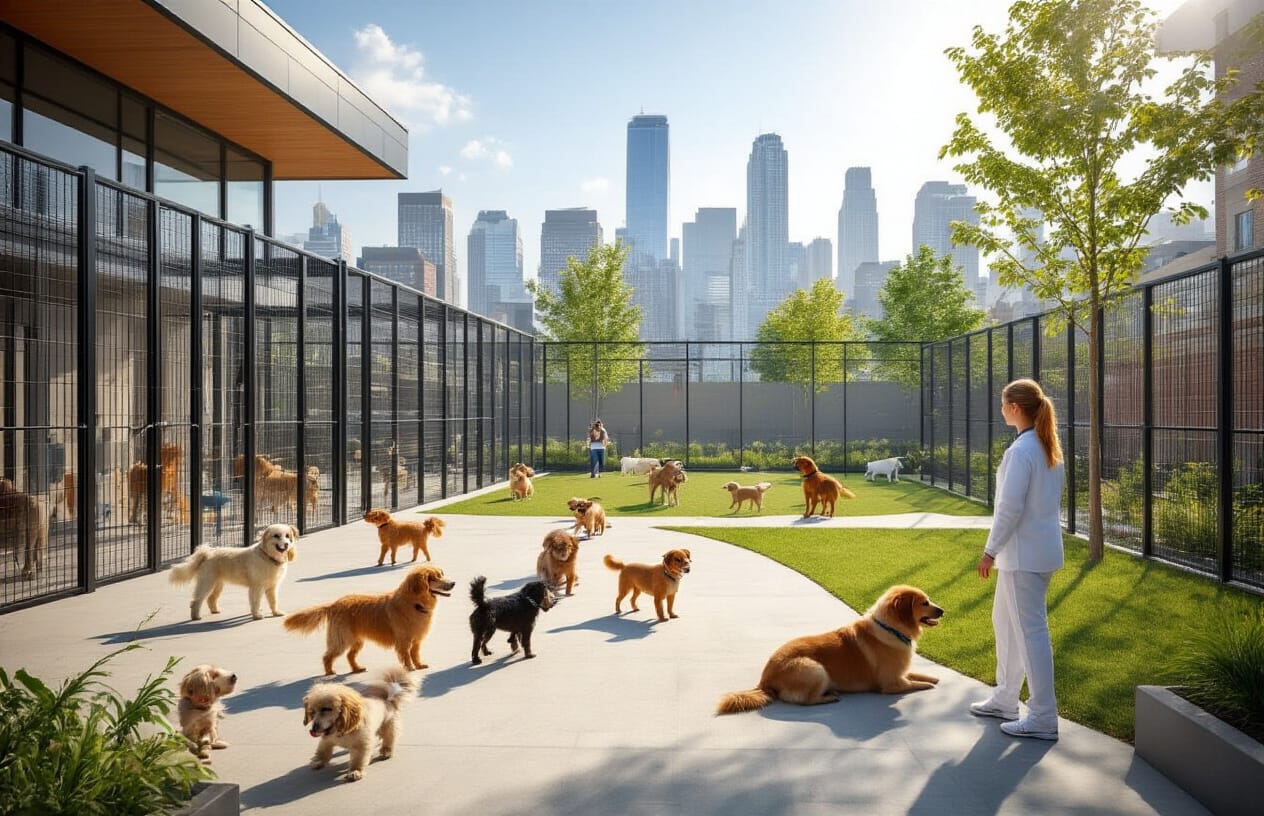
The busy streets and crowded spaces of city life create unique challenges for our four-legged friends at doggy daycare. From traffic hazards and pollution to the increased risk of disease transmission in densely populated areas, urban dog daycares must stay sharp about safety protocols. Proper health screenings, secure facility designs, and well-trained staff aren’t just nice-to-haves – they’re absolute must-haves for keeping dogs safe and happy in the city.
If you’re choosing a daycare for your pup, don’t be shy about asking tough questions. Check if they have solid screening procedures, secure outdoor spaces, and staff who know how to handle urban-specific emergencies. Your dog’s safety depends on these details, and a reputable daycare will be happy to walk you through their protocols. After all, peace of mind is priceless when it comes to your furry family member.
Curious about how to keep your pup safe, happy, and socialized in the heart of Manhattan? Explore our pet care services in Manhattan NYC to see all we offer, learn more About Us to understand our approach and experience, or get in touch on our Contact page to schedule a tour or ask questions. Your furry family member deserves the best – let us show you how we make city dog daycare safe, fun, and stress-free!
Frequently Asked Questions (FAQs)
Dogs should have core vaccines like rabies, DHPP, and bordetella. Depending on the area, additional vaccines such as leptospirosis and canine influenza may be required. Up-to-date documentation must be provided prior to admission.
Safe facilities implement vestibule systems, designated safe zones for drop-offs and pick-ups, visual barriers, and staff-guided transfers to keep dogs away from busy streets and pedestrian congestion.
Modern urban daycares use high-efficiency air filtration, monitor pollution levels, adjust outdoor schedules, and provide indoor play options during high-pollution days to protect dogs’ respiratory health.
Daycares combat noise stress with sound-dampening materials, quiet zones, white noise or calming music, structured quiet periods, and staff trained to recognize stress behaviors in dogs.
Urban facilities maintain detailed evacuation plans, emergency supply kits, staff training for first aid and crisis scenarios, partnerships with local emergency services, and digital check-out systems to ensure safety and accountability during emergencies.

